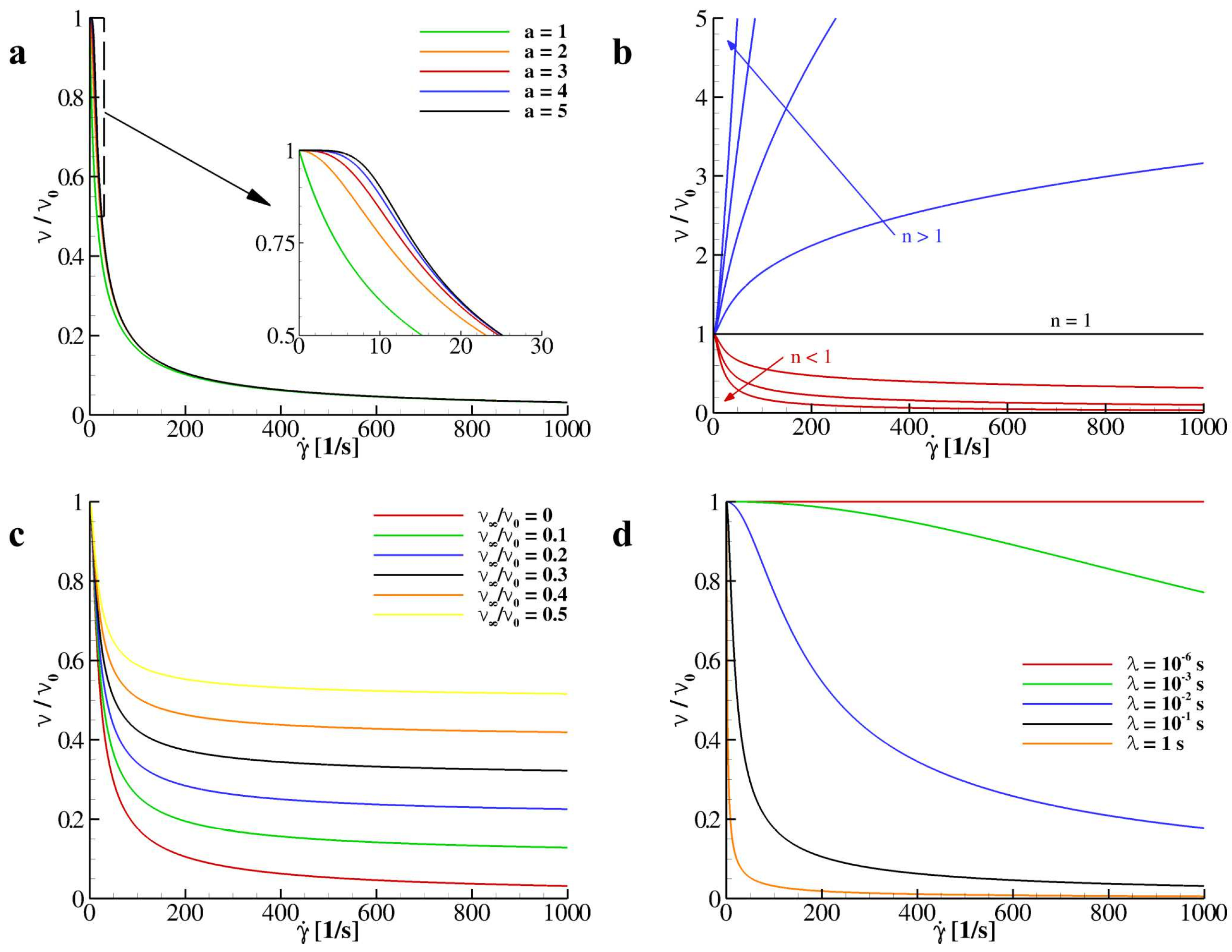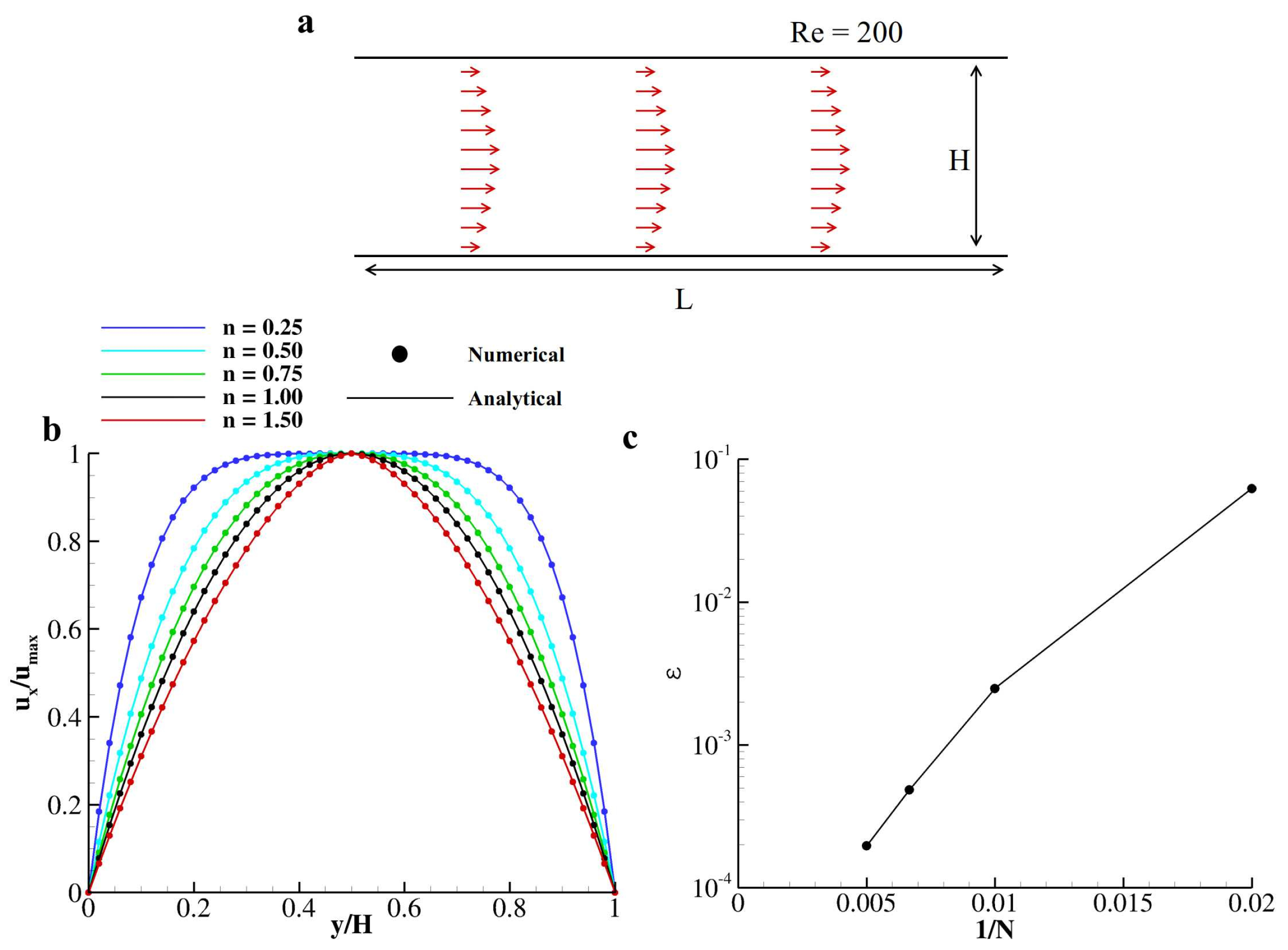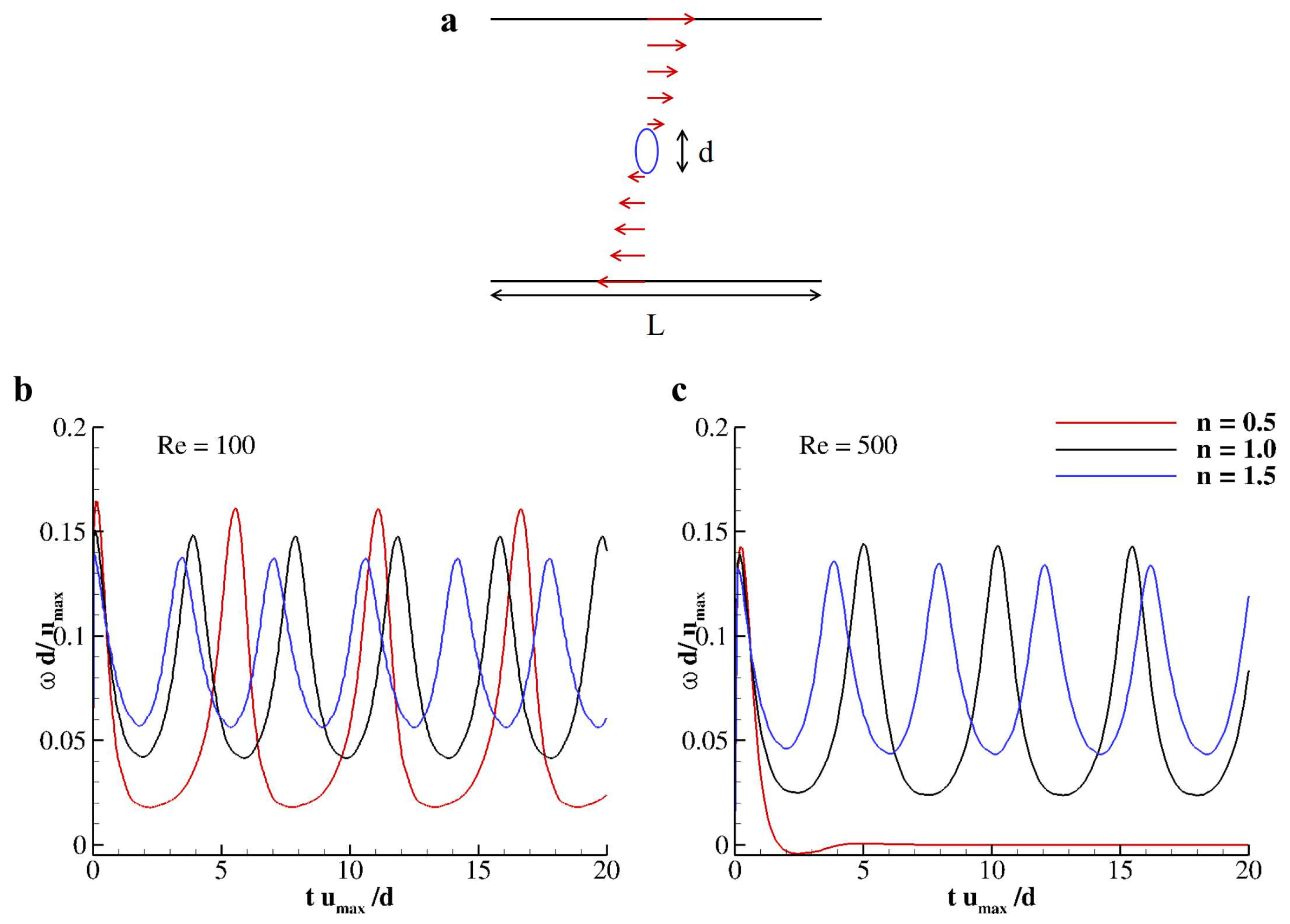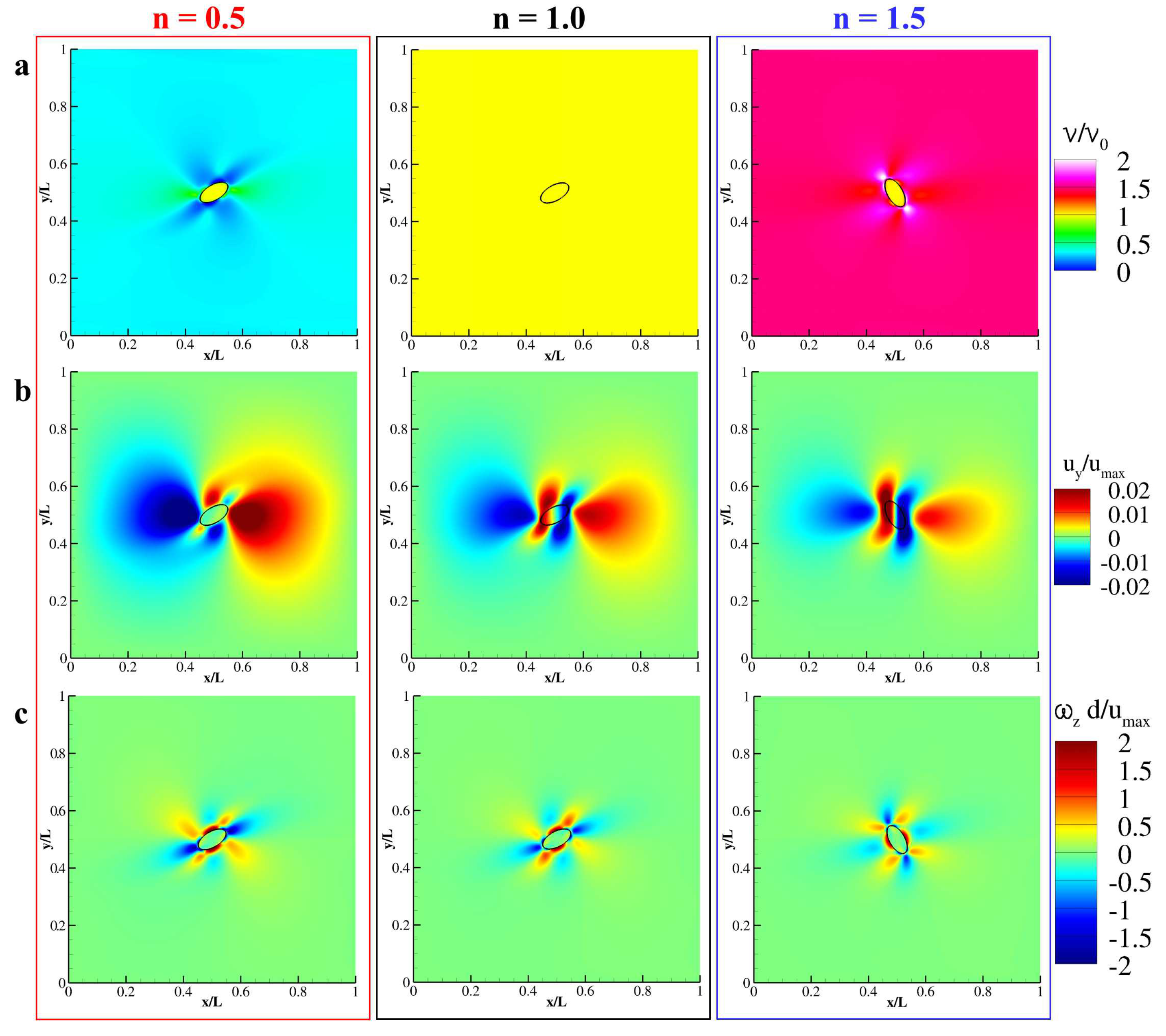Capsules Rheology in Carreau–Yasuda Fluids
Abstract
1. Introduction
2. Computational Method
2.1. Lattice Boltzmann Method
2.2. Shear Induced Apparent Viscosity Treatment
2.3. Immersed Boundary Treatment and Fluid–Structure Interaction
3. Results and Discussion
3.1. Flow within Two Laminae
3.2. Non-Newtonian Fluid in a Lid-Driven Cavity
3.3. Capsules Rotating under Shear
3.4. Transport of Rigid Capsules in a Shear-Thinning Couette Flow
4. Conclusions
Author Contributions
Funding
Acknowledgments
Conflicts of Interest
References
- DeTommasi, D.; Millardi, N.; Puglisi, G.; Saccomandi, G. An energetic model for macromolecules unfolding in stretching experiments. J. R. Soc. Interface 2013, 10, 20130651. [Google Scholar] [CrossRef]
- Florio, G.; Puglisi, G. Unveiling the influence of device stiffness in single macromolecule unfolding. Sci. Rep. 2019, 9, 4997. [Google Scholar] [CrossRef] [PubMed]
- Coclite, G.M.; Florio, G.; Ligabò, M.; Maddalena, F. Nonlinear waves in adhesive strings. SIAM J. Appl. Math. 2017, 77, 347–360. [Google Scholar] [CrossRef]
- Coclite, G.M.; Florio, G.; Ligabò, M.; Maddalena, F. Adhesion and debonding in a model of elastic string. Comput. Math. Appl. 2019, 78, 1897–1909. [Google Scholar] [CrossRef]
- Liu, Y.; Zhang, Z.; Devillanova, G.; Cai, Z. Surface instabilities in graded tubular tissues induced by volumetric growth. Int. J. Non-Linear Mech. 2020, 127, 103612. [Google Scholar] [CrossRef]
- Arai, H.; Kobayashi, K.; Ikeda, K.; Nagao, Y.; Ogihara, R.; Kosaka, K. A computed tomography study of Alzheimer’s disease. J. Neurol. 1983, 229, 69–77. [Google Scholar] [CrossRef]
- Scheltens, P. Imaging in Alzheimer’s disease. Dialogues Clin. Neurosci. 2009, 11, 191. [Google Scholar] [PubMed]
- Peer, D.; Karp, J.; Hong, S.; Farokhzad, O.; Margalit, R.; Langer, R. Nanocarriers as an emerging platform for cancer therapy. Nat. Nanotechnol. 2007, 2, 751–760. [Google Scholar] [CrossRef]
- Antoniades, C.; Psarros, C.; Tousoulis, D.; Bakogiannis, C.; Shirodaria, C.; Stefanadis, C. Nanoparticles: A promising therapeutic approach in atherosclerosis. Curr. Drug Deliv. 2010, 7, 303–311. [Google Scholar] [CrossRef] [PubMed]
- Podduturi, V.P.; Magaña, I.B.; O’Neal, D.P.; Derosa, P.A. Simulation of transport and extravasation of nanoparticles in tumors which exhibit enhanced permeability and retention effect. Comput. Methods Programs Biomed. 2013, 112, 58–68. [Google Scholar] [CrossRef] [PubMed]
- Moghimi, S.; Simberg, D. Nanoparticle transport pathways into tumors. J. Nanopart. Res. 2018, 20, 169. [Google Scholar] [CrossRef] [PubMed]
- Vu, M.N.; Rajasekhar, P.; Poole, D.P.; Khor, S.Y.; Truong, N.P.; Nowell, C.J.; Quinn, J.F.; Whittaker, M.; Veldhuis, N.A.; Davis, T.P. Rapid assessment of nanoparticle extravasation in a microfluidic tumor model. ACS Appl. Nano Mater. 2019, 2, 1844–1856. [Google Scholar] [CrossRef]
- Leal, L.G. The motion of small particles in non-Newtonian fluids. J. Non-Newton. Fluid Mech. 1979, 5, 33–78. [Google Scholar] [CrossRef]
- Avazmohammadi, R.; Castañeda, P.P. The rheology of non-dilute dispersions of highly deformable viscoelastic particles in Newtonian fluids. J. Fluid Mech. 2015, 763, 386. [Google Scholar] [CrossRef]
- Bergenholtz, J.; Brady, J.; Vicic, M. The non-Newtonian rheology of dilute colloidal suspensions. J. Fluid Mech. 2002, 456, 239–275. [Google Scholar] [CrossRef]
- Cwalina, C.D.; Harrison, K.J.; Wagner, N.J. Rheology of cubic particles suspended in a Newtonian fluid. Soft Matter 2016, 12, 4654–4665. [Google Scholar] [CrossRef]
- Decuzzi, P.; Godin, B.; Tanaka, T.; Lee, S.Y.; Chiappini, C.; Liu, X.; Ferrari, M. Size and shape effects in the biodistribution of intravascularly injected particles. J. Control. Release 2010, 141, 320–327. [Google Scholar] [CrossRef]
- Decuzzi, P. Facilitating the clinical integration of nanomedicines: The roles of theoretical and computational scientists. ACS Nano 2016, 10, 8133–8138. [Google Scholar] [CrossRef]
- Coclite, A.; Ranaldo, S.; de Tullio, M.; Decuzzi, P.; Pascazio, G. Kinematic and Dynamic Forcing Strategies for Predicting the Transport of Inertial Capsules Via A Combined Lattice Boltzmann Immersed Boundary Method. Comput. Fluids 2019, 180, 41–53. [Google Scholar] [CrossRef]
- Coclite, A.; de Tullio, M.D.; Pascazio, G.; Decuzzi, P. A combined Lattice Boltzmann and Immersed boundary approach for predicting the vascular transport of differently shaped particles. Comput. Fluids 2016, 136, 260–271. [Google Scholar] [CrossRef]
- Coclite, A.; Mollica, H.; Ranaldo, S.; Pascazio, G.; de Tullio, M.D.; Decuzzi, P. Predicting different adhesive regimens of circulating particles at blood capillary walls. Microfluid. Nanofluid. 2017, 21, 168. [Google Scholar] [CrossRef]
- Coclite, A.; Pascazio, G.; de Tullio, M.; Decuzzi, P. Predicting the vascular adhesion of deformable drug carriers in narrow capillaries traversed by blood cells. J. Fluids Struct. 2018, 82, 638–650. [Google Scholar] [CrossRef]
- Coclite, A.; Gambaruto, A.M. Injection of Deformable Capsules in a Reservoir: A Systematic Analysis. Fluids 2019, 4, 122. [Google Scholar] [CrossRef]
- Lenarda, P.; Coclite, A.; Decuzzi, P. Unraveling the Vascular Fate of Deformable Circulating Tumor Cells Via a Hierarchical Computational Model. Cell. Mol. Bioeng. 2019, 12, 543–558. [Google Scholar] [CrossRef]
- Coclite, A. Vascular journey and adhesion mechanics of micro-sized carriers in narrow capillaries. Microvasc. Res. 2020, 132, 104069. [Google Scholar] [CrossRef] [PubMed]
- Guo, Z.; Shu, C. Lattice Boltzmann Method and Its Applications in Engineering; World Scientific: Singapore, 2013; Volume 3. [Google Scholar]
- de Tullio, M.D.; Pascazio, G. A moving-least-squares immersed boundary method for simulating the fluid-structure interaction of elastic bodies with arbitrary thickness. J. Comput. Phys. 2016, 325, 201–221. [Google Scholar] [CrossRef]
- Wang, C.H.; Ho, J.R. A lattice Boltzmann approach for the non-Newtonian effect in the blood flow. Comput. Math. Appl. 2011, 62, 75–86. [Google Scholar] [CrossRef]
- Ouared, R.; Chopard, B. Lattice Boltzmann simulations of blood flow: Non-Newtonian rheology and clotting processes. J. Stat. Phys. 2005, 121, 209–221. [Google Scholar] [CrossRef]
- Ashrafizaadeh, M.; Bakhshaei, H. A comparison of non-Newtonian models for lattice Boltzmann blood flow simulations. Comput. Math. Appl. 2009, 58, 1045–1054. [Google Scholar] [CrossRef]
- Wang, D.; Bernsdorf, J. Lattice Boltzmann simulation of steady non-Newtonian blood flow in a 3D generic stenosis case. Comput. Math. Appl. 2009, 58, 1030–1034. [Google Scholar] [CrossRef]
- Chai, Z.; Shi, B.; Guo, Z.; Rong, F. Multiple-relaxation-time lattice Boltzmann model for generalized Newtonian fluid flows. J. Non-Newton. Fluid Mech. 2011, 166, 332–342. [Google Scholar] [CrossRef]
- Li, Q.; Hong, N.; Shi, B.; Chai, Z. Simulation of power-law fluid flows in two-dimensional square cavity using multi-relaxation-time lattice Boltzmann method. Commun. Comput. Phys. 2014, 15, 265–284. [Google Scholar] [CrossRef]
- Gabbanelli, S.; Drazer, G.; Koplik, J. Lattice Boltzmann method for non-Newtonian (power-law) fluids. Phys. Rev. E 2005, 72, 046312. [Google Scholar] [CrossRef] [PubMed]
- Yoshino, M.; Hotta, Y.H.; Hirozane, T.; Endo, M. A numerical method for incompressible non-Newtonian fluid flows based on the lattice Boltzmann method. J. Non-Newton. Fluid Mech. 2007, 147, 69–78. [Google Scholar] [CrossRef]
- Boyd, J.; Buick, J.M.; Green, S. Analysis of the Casson and Carreau–Yasuda non-Newtonian blood models in steady and oscillatory flows using the lattice Boltzmann method. Phys. Fluids 2007, 19, 093103. [Google Scholar] [CrossRef]
- Nejat, A.; Abdollahi, V.; Vahidkhah, K. Lattice Boltzmann simulation of non-Newtonian flows past confined cylinders. J. Non-Newton. Fluid Mech. 2011, 166, 689–697. [Google Scholar] [CrossRef]
- Chen, Z.; Shu, C. Simplified lattice Boltzmann method for non-Newtonian power-law fluid flows. Int. J. Numer. Methods Fluids 2020, 92, 38–54. [Google Scholar] [CrossRef]
- Huang, H.; Yang, X.; Krafczyk, M.; Lu, X.Y. Rotation of spheroidal particles in Couette flows. J. Fluid Mech. 2012, 692, 369–394. [Google Scholar] [CrossRef]
- Aidun, C.K.; Lu, Y.; Ding, E.J. Direct analysis of particulate suspensions with inertia using the discrete Boltzmann equation. J. Fluid Mech. 1998, 373, 287–311. [Google Scholar] [CrossRef]
- Zhou, G.; Ge, W.; Li, J. Smoothed particles as a non-Newtonian fluid: A case study in Couette flow. Chem. Eng. Sci. 2010, 65, 2258–2262. [Google Scholar] [CrossRef]
- DeTommasi, D.; Devillanova, G.; Maddalena, F.; Napoli, G.; Puglisi, G. Growth of elastic multiblister driven by geometric contstrain. Proc. R. Soc. A 2020. submitted. [Google Scholar]
- Du, R.; Shi, B.; Chen, X. Multi-relaxation-time lattice Boltzmann model for incompressible flow. Phys. Lett. 2006, 359, 564–572. [Google Scholar] [CrossRef]
- Qian, Y.H.; D’Humieres, D.; Lallemand, P. Lattice BGK Models for Navier-Stokes Equation. EPL Europhys. Lett. 1992, 17, 479. [Google Scholar] [CrossRef]
- Krüger, T.; Kusumaatmaja, H.; Kuzmin, A.; Shardt, O.; Silva, G.; Viggen, E. The Lattice Boltzmann Method: Principles and Practice; Springer: Berlin/Heidelberg, Germany, 2017. [Google Scholar]
- Zou, Q.; He, X. On pressure and velocity boundary conditions for the lattice Boltzmann BGK model. Phys. Fluids 1997, 9, 1591–1598. [Google Scholar] [CrossRef]
- Favier, J.; Revell, A.; Pinelli, A. A Lattice Boltzmann-Immersed Boundary method to simulate the fluid interaction with moving and slender flexible objects. J. Comput. Phys. 2014, 261, 145–161. [Google Scholar] [CrossRef]
- Napolitano, M.; Pascazio, G. A numerical method for the vorticity-velocity Navier-Stokes equations in two and three dimensions. Comput. Fluids 1991, 19, 489–495. [Google Scholar] [CrossRef]
- Jeffery, G.B. The motion of ellipsoidal particles immersed in a viscous fluid. Proc. R. Soc. London. Ser. Contain. Pap. Math. Phys. Character 1922, 102, 161–179. [Google Scholar]
- Zettner, C.; Yoda, M. Moderate-aspect-ratio elliptical cylinders in simple shear with inertia. J. Fluid Mech. 2001, 442, 241–266. [Google Scholar] [CrossRef]







| (a) Re = 1000 | |
| n | South-Wall Min. [y/L] |
| (b) Re = 5000 | |
| n | South-Wall Min. [y/L] |
| (a) AR = 2 | ||
| n | c | Re |
| 80 | 300 | |
| 180 | 2005 | |
| 250 | 4750 | |
| (b) AR = 3 | ||
| n | c | Re |
| 58 | 97 | |
| 150 | 765 | |
| 250 | 3500 | |
Publisher’s Note: MDPI stays neutral with regard to jurisdictional claims in published maps and institutional affiliations. |
© 2020 by the authors. Licensee MDPI, Basel, Switzerland. This article is an open access article distributed under the terms and conditions of the Creative Commons Attribution (CC BY) license (http://creativecommons.org/licenses/by/4.0/).
Share and Cite
Coclite, A.; Coclite, G.M.; De Tommasi, D. Capsules Rheology in Carreau–Yasuda Fluids. Nanomaterials 2020, 10, 2190. https://doi.org/10.3390/nano10112190
Coclite A, Coclite GM, De Tommasi D. Capsules Rheology in Carreau–Yasuda Fluids. Nanomaterials. 2020; 10(11):2190. https://doi.org/10.3390/nano10112190
Chicago/Turabian StyleCoclite, Alessandro, Giuseppe Maria Coclite, and Domenico De Tommasi. 2020. "Capsules Rheology in Carreau–Yasuda Fluids" Nanomaterials 10, no. 11: 2190. https://doi.org/10.3390/nano10112190
APA StyleCoclite, A., Coclite, G. M., & De Tommasi, D. (2020). Capsules Rheology in Carreau–Yasuda Fluids. Nanomaterials, 10(11), 2190. https://doi.org/10.3390/nano10112190






